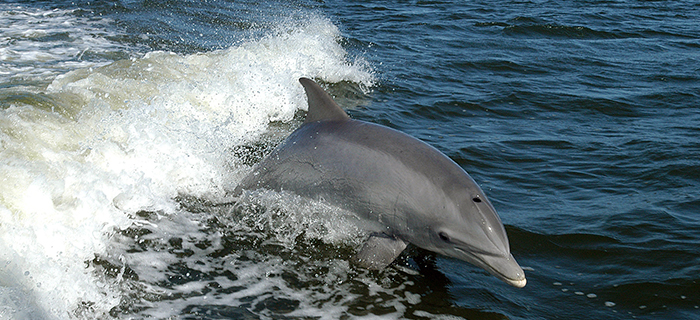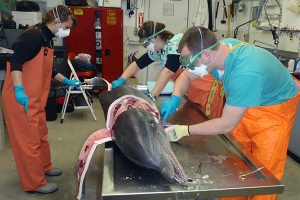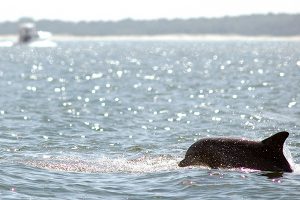Dolphin Mania: Technology boosts public eye

Bottlenose dolphins; courtesy of NASA
The earliest recorded historical accounts of dolphins were approximately 1600 B.C., where they were found depicted on ancient frescoes in the Palace of Knossos on the Greek Island of Crete.
According to author Chris Catton, the image of dolphins rescuing sailors or carrying humans recurs again and again in myth and folklore.
“The sculptures, the mosaics, the beautifully engraved and painted pottery,” he explains, “tell us that they were important, but not why.”
| Dolphin data Are we seeing more dolphins in the Chesapeake Bay? Amanda Weschler, the Marine Mammal and Sea Turtle Stranding Response Coordinator for the Maryland Department of Natural Resources Fishing and Boating Services says probably not. “Our Stranding Response Program has been around for almost 30 years. In comparing our historical data with current trends for both sightings and strandings, 2018 is very much like every other year, and contrary to what has become popular belief, we really aren’t seeing anything out of the ordinary.” She believes that it may seem like there are “more” dolphins simply because of accessibility to technology. “In the past, the general public could potentially see a pod of dolphins, and this report got passed by word-of-mouth through a chain of parties before reaching the correct source,” Weschler says. “As we are all aware, social media means sightings can be shared immediately. Based on our current data, there aren’t necessarily more dolphins, just an abundance of outlets where people can report animals in real time, creating the perception there are more.”
Photo: Weschler (left) and team performing a necropsy; staff photo Keeping track Records are sparse through the mid-1900s and consist of a variety of species. The first stranding reported of a harbor porpoise was on Assateague Island in 1949. Fifty-seven marine mammals in all are listed in the database from 1900-1986, before the Maryland Department of Natural Resources established the Stranding Response Program in 1990. In the nearly three decades since, staff have responded to more than 220 stranded bottlenose dolphins, and recorded 298 marine mammal sightings. In total, they have seen nearly 500 stranded marine mammals, representing 25 different species. Of these, seven different species of dolphins including Atlantic white-sided, bottlenose, Clymene, Risso’s, short-beaked common, spotted, and striped have been recorded. While some sightings were for single animals or smaller pods, many sightings were for large pods of 20-50 animals, suggesting that more than 1,000 dolphins could be in the bay during peak season. The Stranding Response Program leads the state in documenting and receiving sighting and stranding reports for dolphins and other marine life. The Maryland Natural Resources Police is an integral part by maintaining a toll-free hotline, available 24/7. Live animal calls are referred to the National Aquarium, while dead animal cases are directed to the Stranding Response Program located at the Cooperative Oxford Laboratory. Report sightings to 800-628-9944. |
Centuries later and much closer to home, English explorer Capt. John Smith became captivated by the Chesapeake Bay and its abundant wildlife, which also included dolphins.
He called the Chesapeake, “A country that may have the prerogative over the most pleasant places known, for large and pleasant navigable rivers, heaven and earth never agreed better to frame a place for man’s habitation [that was full of] sturgeon, grampus, porpoise, seals, stingrays … brits, mullets, white salmon [rockfish], trouts, soles, perch of three sorts, where the oysters lay as thick as stones.”
Species
In Maryland, the bottlenose dolphin (Tursiops truncatus) is the most commonly encountered marine mammal, with sightings throughout the state as far north as Pooles Island in Harford County.
Bottlenose dolphins are intelligent, social animals, and are abundant along the mid-Atlantic Coast during warmer months—usually late April through October.
Sightings of groups of dolphins, referred to as pods, can range from 2-3 dolphins to a few hundred.
Sightings
Could there really be 1,000 (or more!) dolphins in the Chesapeake Bay in the summer? Researcher Helen Bailey believes so. Based out of the University of Maryland Center for Environmental Science Chesapeake Biological Laboratory, Dr. Bailey and her team are studying how often dolphins come into bay, how long they spend there, which areas they are using and why. With funding support from the Chesapeake Bay Trust, Dr. Bailey founded DolphinWatch, a web-based research project that allows people to share dolphin sightings using their smartphones.
“Citizens can be very good community scientists,” she said. “The more eyes we have on the water reporting sightings, the better.”
Protection
While encountering dolphins can be an exciting experience, the Maryland Department of Natural Resources requests all sightings be reported to their hotline.
All marine mammals (dolphins, porpoises, manatees, seals and whales) are federally protected under the Marine Mammal Protection Act, which prohibits the feeding, harassment or interaction with live animals, as well as the collection and interaction of dead, stranded animals. Additionally, manatees, sea turtles and whales are listed under the Endangered Species Act, with violations resulting in confiscation, fines and imprisonment.
It is very important for citizens to know and remember that all of these animals are protected by both federal and state law, and whether alive or dead, should be observed from a safe distance.
Article by Linda Wiley—Office of Communications webmaster. Appears in Vol. 21, No. 4 of the Maryland Natural Resource magazine, fall 2018.




 1-888-373-7888
1-888-373-7888 233733
233733